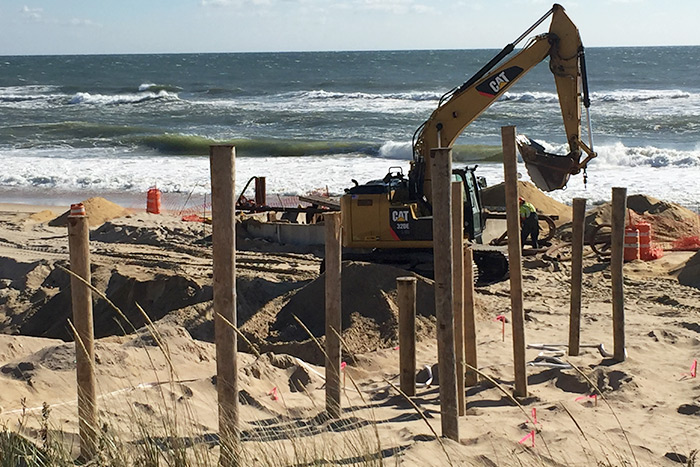Army Corps Defends Their Work in Montauk: Dan Responds

Colonel David Caldwell, the chief of the local Army Corps of Engineers, has sent a reply to my editorial that damned the Corps’ reinforced dune project in Montauk after it broke down during the recent storm.
In it, he offers to correct “various inaccuracies” in my editorial. He writes that the collapse of the dune project was just 200 feet, not 300 feet. (Our Town Supervisor measured it at 300 feet.) He writes that the collapse was expected. The sand got washed out and the sandbags were exposed because that is what was supposed to happen in a storm. It “performed as designed.”
He writes that the Army Corps will restore the damaged section and that my saying that the Corps wanted to dispute who would pay for the repair was not true. He is right about that. Who would pay for it was up in the air for a time. That’s when the article was written.
He also writes that any suggestion that the Town was “not aware of their responsibilities” in repairing collapses in the future is incorrect. I never said they were not aware of them. I said they should never have signed onto this project in the first place.
Further to this point, it is fair to say that the Town Board and the townspeople were under the impression that a washed-out dune was being restored with a solid sandbag spine inside so this summer resort would remain beautiful and safe from flooding as it was in prior years. We were not aware that having the sand wash out in a modest storm (two foot high tide) exposing the sandbags was “what it was supposed to do.” Considering the present situation with the sandbags exposed and some of them ripped, my guess is that they will stay that way for all to see for months before repairs occur. Indeed, Colonel Caldwell wrote that the Corps is “developing a plan to restore the damaged section of dune with sand with 100% federal funds.” You know how it is with getting these jobs going.
And as a matter of fact, there is no way that town bulldozers would even be allowed to step in to make the repair now. It will be the case when the paperwork says the town takes on that responsibility AFTER the project is turned over to the town, as agreed upon. It is not turned over because it is not yet “done.” Once it’s fixed, if they hurry up and sign the papers and it collapses again, THEN the town will be responsible and can send in the bulldozers.
In his letter, Colonel Caldwell does not dispute my assertions that originally the Town expected a broad beach of sand, perhaps 200 yards of it, in front of the sandbags acting as the “sacrificial” sand that could get temporarily washed out in a storm. And instead, what we got was three feet of sand protecting the face of the sandbags and atop the sandbags, and that was all—and THAT would be the “sacrificial” sand.
Colonel Caldwell writes that “long before a Corps project commences, a team of professionals complete detailed studies, evaluations and cost-benefit analysis to ensure…maximum benefit,” so they know what they are doing.
The fact is that a stretch of new all-sand dunes placed in front of Sagaponack and Southampton Town—a distance of five miles (nearly 10 times the length of the Montauk dune project) held up just fine in the recent storm. This $30 million project was paid for by the property owners there. And its experts, who had overseen the repair of a similar and successful 10-mile-long dune replenishment project in Nags Head, North Carolina, said a 200-yard-wide beach that includes sand that’s underwater at high tide would be sufficient as both the stay-there sand and the “sacrificial” sand as the beach washes in and out. Not sand pasted on sandbags.
You can read Colonel Caldwell’s letter below.
***
To the Editor:
In response to the September 19 editorial in Dan’s Papers, “Hermine Proves Army Corps Naysayers Right in Montauk,” the Army Corps of Engineers would like to correct various inaccuracies.
First, some context. While Hermine did not make landfall, it did stall off Long Island for several days, subjecting the shoreline to high surf and damaging waves for multiple high-tide cycles. This is much different than a storm that moves through quickly. Historically, many slow-moving, moderate storms have actually caused more erosion than more powerful storm events. Saying Hermine was ‘not a big deal’ and ‘a little storm’ is inaccurate in this instance. Every storm is different and myriad variables influence shoreline impact(s).
I am sure, as a responsible member of the media that you would want your readers to know accurate facts:
1) Hermine damaged approximately 200 (not 300) feet of a 3,200-foot-long project, a small fraction (just above 6%), certainly not ‘a considerable part’ of the project as stated in your editorial. The project also performed as designed: There were no reports of flooding or damage behind the dune and the sand acted as a sacrificial buffer with the geotextile bags preventing further erosion which would have certainly occurred without their presence.
2) Contrary to the article, the Corps is developing a plan to restore the damaged section of dune and cover the geotextile bags with sand with 100% federal funds because the project is not yet turned over to the local sponsor. Your assertion, ‘I am told the Army Corps wants to dispute this repairing of the dune’ is simply not true.
3) The Town of East Hampton is the local sponsor for the project and the New York State Department of Environmental Conservation (NYSDEC) is the non-federal sponsor. As the local sponsor, the Town of East Hampton will assume responsibility for operation and maintenance of the project after completion. Any suggestion that the Town Board was not aware of these responsibilities inferred in the editorial ‘The Town Board for accepting this project was wrong’ is incorrect. Sand replacement for the overall project is a routine operations and maintenance requirement for the local sponsor which was part of the partnership agreement prior to the start of construction.
More broadly, the U.S. Army Corps of Engineers, New York District, has a strong record of success reducing flood risks from severe storms: During Sandy, areas with Corps projects in place fared better than those without such projects—experiencing far less flooding and saving millions in potential damage to homes and infrastructure, as was the case in places like Coney Island. Further, the tone of the article clearly discrediting and mocking the credibility of the Corps of Engineers is misguided and unfair at best. The Army Corps works diligently to reduce flood risks to communities across the U.S. and around the world, in addition to many other civil works projects benefiting the public.
Your publication is certainly entitled to its opinion; we respect that. However, my expert team and I strongly dispute your conclusions about this project—conclusions that have no basis in fact from a scientific, engineering and policy standpoint. In summation, a knee-jerk reaction to the relatively minor impact to the project in Montauk, which is being used to broadly denounce the entire body of work of a federal agency is at best misguided and off base.
Long before a Corps project commences, a team of professionals complete detailed studies, evaluations, cost-benefit analysis to ensure taxpayer money is being spent for maximum benefit and community outreach-to explain to stakeholders both political & constituent what will be done and why. ALL of these steps took place in Downtown Montauk and any assertion to the contrary is simply not true, I suspect you have higher standards for your publication which I urge you to pursue.
COL David A. Caldwell
District Engineer and Commander
New York District, U.S. Army Corps of Engineers



